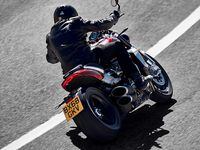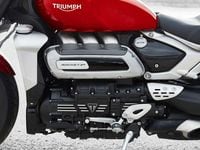Triumph revealed the limited-edition Rocket 3 TFC in May, and all 750 units (225 for the US) were snapped up at their $29,000 MSRP. Now we have a full look at the regular production bikes, the Rocket 3 R and Rocket 3 GT. Both feature the all-new three-cylinder engine displacing a massive 2,458cc, making it the largest production motorcycle engine in the world.
An engine this big can't help but be the centerpiece of the newest Triumph, and it's an impressive-looking mill that has power numbers commensurate with its outrageous displacement. Triumph claims 165 crankshaft horsepower for the new Rocket, a modest bump of 11 percent over the previous 2,294cc triple that originally debuted in 2004.
But the key driver to the Rocket’s propulsion is its ridonculous torque: The purported 163 pound-feet of twist is more than any other motorcycle engine. Peak torque is achieved at 4,000 rpm, while max power is hit at 6,000 rpm on the way to the engine’s higher rev limit of 7,000 rpm.
What’s new inside? Everything, including the crankcases and all internal parts. Piston bores go up from 101.6mm to 110.2, while their strokes narrow from 94.3mm to 85.9. Incredibly, Triumph claims the weight of the powerplant has dropped a ginormous 40 pounds.
Moderate clutch effort is promised by a torque-assist hydraulic clutch working with a six-speed gearbox. A hydroformed header arrangement looks butch and distinctive, routing exhaust gases to a collector that has three exits (one on the left side). A ride-by-wire throttle allows different riding modes and standard cruise control.
Speaking of electronics, the Rocket 3 has most of the latest doo-dads. A five-axis Continental IMU informs traction control and cornering ABS, while new color TFT instrumentation informs a rider. The gauges are angle adjustable and can display two layouts, and its start-up screen is customizable to allow riders to display their names or whatever. The settings are controlled by illuminated switch cubes on the switchgear.
Keyless ignition enables simple start-up, while hill-hold control keeps the 650-some-pound (claimed, dry) bike from unexpectedly rolling away when stopped on a slope.
The Rockets share aluminum frames, with a semi-sporty 27.9-degree rake angle and 5.3 inches of trail. An attractive single-sided swingarm places wheels 66 inches apart. A 150mm front tire combined with a 240mm rear make us wonder how much they will negatively affect steering dynamics. Adjustable Showa suspension should shrug off most bumps, while high-end Brembo Stylema four-piston monoblock front brake calipers and 320mm discs scrub 165-hp speeds. We nominate the Rocket for title of most robust rear brake caliper: a Brembo M4.32 four-piston monoblock caliper and 300mm rotor.
The Rocket 3 R is “the ultimate muscle roadster,” according to Triumph. Meanwhile, the Rocket 3 GT “is built to go even further, in more comfort.” As such, the GT’s handlebar is pulled back and its seat unit is plusher and lower (29.5 versus 30.4 inches) and includes a brushed aluminum passenger backrest that adjusts for height.
Kudos to Triumph for including footpeg adjustments on both new Rockets. The R’s pegs are mid-mounted and can be set to either of two vertical positions. The GT’s pegs are placed farther forward at your choice of three horizontal positions over a 2-inch span.
Both iterations can be had in Phantom Black, and the R is also available in Korosi Red. The GT’s color option is a two-tone Silver Ice and Storm Grey with Korosi Red pinstriping.
Notable extra-cost options include Shift Assist for clutchless up and down shifting, an integrated GoPro control system, a Bluetooth connectivity module, Google navigation, and a tire-pressure-monitoring system. There are also more than 50 new accessories for the Rocket 3, including aluminum saddlebags, seats, handlebars, and a quick-release tailbag.
This is the stage where we usually would disclose how much these double triples will cost when they hit dealers in January 2020. Except Triumph is making us wait until November before prices are announced.
Based on the Rocket 3’s plethora of features and its high level of finish detail, Triumph is clearly moving the model upmarket. Having internally wired handlebars and an aluminum frame costs extra, as do the brushed aluminum airbox covers and Monza-style oil and radiator caps. Other tasty but pricey bits include the graceful folding passenger footpegs and brushed stainless steel tank strap.
The Rocket III previously retailed for around $15,000, but the Rocket 3s will surely cost considerably more. Not only are we buying a more powerful and more beautiful (and costlier to build) engine, we’re also buying TFTs and IMUs and Stylemas.
If we’re lucky, the Rocket 3’s MSRP will begin at $20,000. If we’re realistic, maybe $22K. An optioned-up GT version might begin to crowd the Rocket 3 TFC’s price.
Whatever it costs, it’s sure to provide an unmistakable ride. The Rocket III proved to be way more fun to ride than expected, and the Rocket 3 seems like it will perform several leagues above while looking far more dashing than its agricultural-ish predecessor.


















/cloudfront-us-east-1.images.arcpublishing.com/octane/QSTCM6AVEZA5JJBUXNIQ3DSOF4.jpg)
/cloudfront-us-east-1.images.arcpublishing.com/octane/U4I7G625B5DMLF2DVIJDFZVV6M.jpg)
/cloudfront-us-east-1.images.arcpublishing.com/octane/B6XD6LS6IVCQPIU6HXDJSM3FHY.jpg)
/cloudfront-us-east-1.images.arcpublishing.com/octane/ICL63FEDDRDTTMINYICCEYGMDA.jpg)
/cloudfront-us-east-1.images.arcpublishing.com/octane/FCGZHQXRBZFLBAPC5SDIQLVF4I.jpg)
/cloudfront-us-east-1.images.arcpublishing.com/octane/WNOB6LDOIFFHJKPSVIWDYUGOPM.jpg)

/cloudfront-us-east-1.images.arcpublishing.com/octane/X33NU3E525ECRHXLNUJN2FTRKI.jpg)
/cloudfront-us-east-1.images.arcpublishing.com/octane/6KKT5NNL2JAVBOXMZYS5ZO76YA.jpg)
/cloudfront-us-east-1.images.arcpublishing.com/octane/J5RKG5O455GMPGQRF2OG6LRT7A.jpg)
/cloudfront-us-east-1.images.arcpublishing.com/octane/GX2CIZKQVRH2TATDM26KFG2DAE.jpg)
/cloudfront-us-east-1.images.arcpublishing.com/octane/ZWIDYSAKQZHD5BHREMQILXJCGM.jpg)
/cloudfront-us-east-1.images.arcpublishing.com/octane/CYUHJZCTSJCH3MRAQEIKXK7SCQ.jpg)
/cloudfront-us-east-1.images.arcpublishing.com/octane/LKOFINY56FCXJCANJ5M7ZDQUBY.jpg)
/cloudfront-us-east-1.images.arcpublishing.com/octane/4NBPDACMWJH63JQYJVK3QRBDZI.jpg)
/cloudfront-us-east-1.images.arcpublishing.com/octane/KKHQHRR3FJGX7H2IPU6RALMWG4.jpg)

/cloudfront-us-east-1.images.arcpublishing.com/octane/5IOFS5JAE5FOXMNA23ZRAVVYUU.jpg)
/cloudfront-us-east-1.images.arcpublishing.com/octane/CGXQ3O2VVJF7PGTYR3QICTLDLM.jpg)

/cloudfront-us-east-1.images.arcpublishing.com/octane/OQVCJOABCFC5NBEF2KIGRCV3XA.jpg)
/cloudfront-us-east-1.images.arcpublishing.com/octane/OPVQ7R4EFNCLRDPSQT4FBZCS2A.jpg)
/cloudfront-us-east-1.images.arcpublishing.com/octane/YBPFZBTAS5FJJBKOWC57QGEFDM.jpg)
/cloudfront-us-east-1.images.arcpublishing.com/octane/W5DVCJVUQVHZTN2DNYLI2UYW5U.jpg)